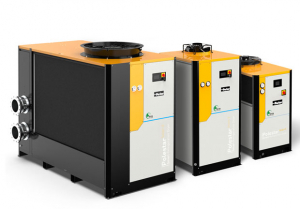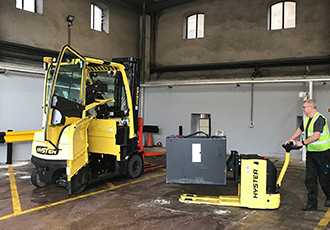MAPAL Quadruples tool life for composite machining
18th October 2012
Source:
MAPAL Ltd
Approached by Mayr Faserverbundtechnik for help in optimising milling operations on a composite component, MAPAL developed an innovative solution that not only quadrupled tool life but also significantly reduced machining time and eliminated the need for manual reworking and finishing.
For the components used in the new design of an operating table, CFRP composite was the ideal choice of material as it’s exceptionally strong, lightweight and transparent to X-rays. However, machining this material presents significant challenges, including difficulties in obtaining good tool life and in combining a high machining rate with a quality finish.
These are exactly the challenges faced by Mayr Faserverbundtechnik in the production of a tongue-shaped composite component that plays a key role in the new operating table. This requires two milling operations, which are carried out in two clamping positions on a machining centre with an SK40 spindle. The first operation trims the periphery of the component, while the second mills two guide slots.
Before it approached MAPAL, Mayr Faserverbundtechnik was using two milling tools for these operations – a solid carbide router for roughing and a PCD end mill for finishing. The performance achieved was, however, far from impressive. The tool life was just 45 components, the surface quality obtained was so poor that additional manual reworking and finishing was needed, and the machining time per component was more than seven minutes.
Engineers from MAPAL were, however, able to draw on their extensive experience of working with CFRP materials to develop an innovative solution that provides greatly improved results. The new machining process uses an OptiMill-Composite-Speed diamond-coated solid carbide end mill with eight cutting edges, which makes it possible to complete all of the milling operations on the component in a single machining step.
The novel geometry of the tool and serrations in the cutting edges ensure optimal chip removal and, therefore, permit high machining rates to be achieved. The tool has a diameter of 8 mm over its entire length of 32 mm.
With the component, which is approximately 10 mm thick, clamped in the first position, trimming is carried out with roughing and finishing performed in one machining step. During this operation, the milling cutter is lowered slightly so that only the rear cutting portion of the tool is used, leaving the front face geometry fully available for machining the guide slots when the component is clamped in the second position.
These slots, which are approximately 5 mm deep, are cut without problems by the cutting face geometry of the OptiMill-Composite-Speed tool, and the tolerances required for the component are easily achieved. To prevent delamination during the machining operations, synchronous milling is used.
The results achieved with the new tool and process are impressive. Tool life has been increased from 45 to 200 parts, while machining time has been reduced by 32%. In addition, because of the excellent surface finish achieved with the OptiMill-Composite-Speed tool, the need for manual reworking and finishing of the components has been completely eliminated.
These are exactly the challenges faced by Mayr Faserverbundtechnik in the production of a tongue-shaped composite component that plays a key role in the new operating table. This requires two milling operations, which are carried out in two clamping positions on a machining centre with an SK40 spindle. The first operation trims the periphery of the component, while the second mills two guide slots.
Before it approached MAPAL, Mayr Faserverbundtechnik was using two milling tools for these operations – a solid carbide router for roughing and a PCD end mill for finishing. The performance achieved was, however, far from impressive. The tool life was just 45 components, the surface quality obtained was so poor that additional manual reworking and finishing was needed, and the machining time per component was more than seven minutes.
Engineers from MAPAL were, however, able to draw on their extensive experience of working with CFRP materials to develop an innovative solution that provides greatly improved results. The new machining process uses an OptiMill-Composite-Speed diamond-coated solid carbide end mill with eight cutting edges, which makes it possible to complete all of the milling operations on the component in a single machining step.
The novel geometry of the tool and serrations in the cutting edges ensure optimal chip removal and, therefore, permit high machining rates to be achieved. The tool has a diameter of 8 mm over its entire length of 32 mm.
With the component, which is approximately 10 mm thick, clamped in the first position, trimming is carried out with roughing and finishing performed in one machining step. During this operation, the milling cutter is lowered slightly so that only the rear cutting portion of the tool is used, leaving the front face geometry fully available for machining the guide slots when the component is clamped in the second position.
These slots, which are approximately 5 mm deep, are cut without problems by the cutting face geometry of the OptiMill-Composite-Speed tool, and the tolerances required for the component are easily achieved. To prevent delamination during the machining operations, synchronous milling is used.
The results achieved with the new tool and process are impressive. Tool life has been increased from 45 to 200 parts, while machining time has been reduced by 32%. In addition, because of the excellent surface finish achieved with the OptiMill-Composite-Speed tool, the need for manual reworking and finishing of the components has been completely eliminated.
Similar articles
More from MAPAL Ltd
- Milling cutter for the highly efficient universal machining of steel 28th February 2017
- Companies come together to prevent damage to machinery 14th July 2016
- MAPAL bores faster for produmax 28th January 2016
- Tool life tripled with MAPAL’s new cutting material 7th January 2016




.jpg)







Write a comment
No comments